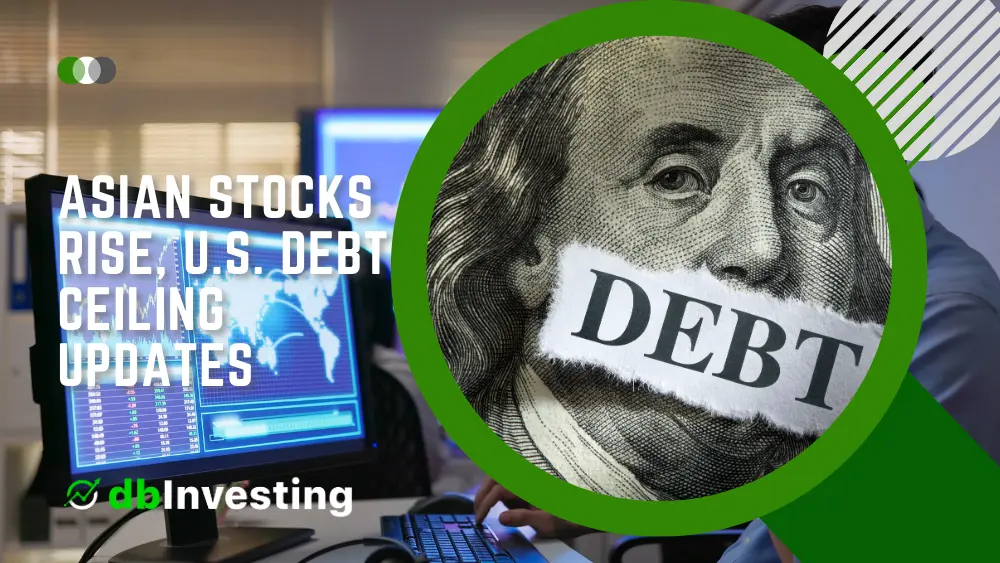Asian equities experienced a surge as regional chip shares rallied on Monday, driven by the ban imposed by China on certain purchases from Micron Technology (MU.O). However, Wall Street futures faced struggles as negotiations regarding the U.S. debt ceiling approached a critical point after experiencing a setback last week.
Caution extended to the European markets, with pan-regional Euro Stoxx 50 futures indicating a lackluster start. S&P 500 futures remained relatively stable, while Nasdaq futures displayed a modest increase of 0.1%.
Today, U.S. President Joe Biden and House Republican Speaker Kevin McCarthy are scheduled to meet and discuss the impending debt ceiling issue. The meeting takes place less than two weeks before the June 1 deadline, which the Treasury anticipates will present challenges in meeting the federal government’s debt obligations.
A failure to raise the debt ceiling would trigger a default, leading to potential turmoil in financial markets and a significant spike in interest rates.
The MSCI’s broadest index of Asia-Pacific shares outside Japan (.MIAPJ0000PUS) climbed by 0.5%. Japan’s Nikkei (.N225) soared by 0.8%, reaching new highs not seen in 33 years. South Korea’s KOSPI (.KS11) recorded a gain of 0.7%, and Hong Kong’s Hang Seng index (.HSI) surged by an impressive 1.3%.
The sentiment was further uplifted by President Biden’s optimistic remarks regarding the expected improvement in strained relations with China, expressing anticipation for a resolution in the near future.
On Sunday, Beijing imposed a ban on U.S. company Micron’s sales of memory chips to critical domestic industries due to security concerns. This move had a positive impact on the stocks of Micron’s competitors in China and elsewhere, as mainland companies sought alternative sources for memory products.
In other news, concerns over the upcoming U.S. debt ceiling negotiations continued to unsettle the market.
Chris Weston, Head of Research at Pepperstone, remarked, “In the art of brinkmanship, it feels that to get a deal we must see greater market volatility.” He noted that although last week’s headlines indicated a potential deal within reach, the breakdown in talks among Republican negotiators on Friday led many to believe that an agreement may only be reached right before the June deadline.
Jonathan Pingle, U.S. Chief Economist at UBS, identified the Japanese yen and gold as the best positions to benefit from a U.S. default. He suggested that only if the impasse extends for one month after the X-date, would financing conditions tighten significantly enough to cause a substantial rally in the dollar.
The news of an impasse in debt ceiling negotiations on Friday rattled the markets, even as Federal Reserve Chairman Jerome Powell expressed the possibility that U.S. interest rates might not need to rise as much, considering the tighter credit conditions resulting from the banking crisis.
Futures currently indicate a roughly 90% probability that the Fed will maintain interest rates at their current level during the upcoming June meeting. Additionally, expectations suggest a total reduction of nearly 50 basis points by the end of the year.
Consequently, the dollar’s recent strength against major currencies has weakened, and it currently hovers around 103.05 on Monday, showing little change throughout the day.
Meanwhile, regional U.S. bank shares continued their decline on Friday as Treasury Secretary Janet Yellen reportedly hinted at the possibility of further mergers following a series of bank failures.
In Asia, despite a disappointing ongoing economic recovery, China opted to keep its key lending rates unchanged on Monday. Market participants are also analyzing the implications of the Group of Seven’s “de-risk, not decouple” approach to China and the supply chain issues discussed during the summit held on Sunday.
In response to the summit, Beijing summoned the Japanese ambassador to express its dissatisfaction with the “hype around China-related issues.”
Later this week, the Federal Reserve will release the minutes of its May meeting on Wednesday, and U.S. personal consumption expenditures (PCE) inflation data will be announced on Friday.
Concerns surrounding the debt ceiling have resulted in significant distortions in the short end of the Treasury yield curve, as investors shy away from bills that mature when the Treasury faces the risk of running out of funds.
On Monday, the yield on the 1-month Treasury bill surged by 15 basis points to 5.6677%. Meanwhile, two-year yields decreased by five basis points to 4.2387%, retracting from recent two-month highs. The 10-year yield also experienced a four basis points decline, settling at 3.6536%.
Oil prices faced a decline, with U.S. crude futures dropping by 0.9% to $70.94 per barrel, while Brent crude futures fell by 0.8% to $75.01 per barrel.
Gold prices remained largely stable at $1,976.19 per ounce.




